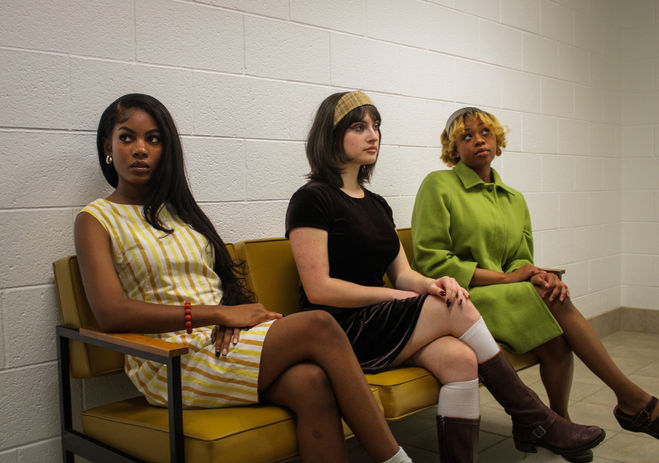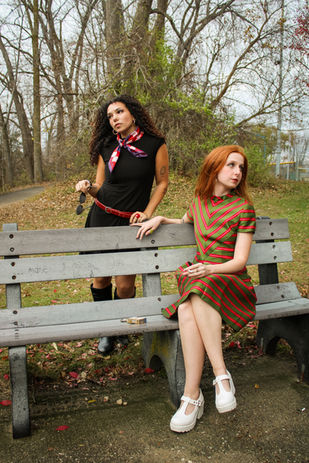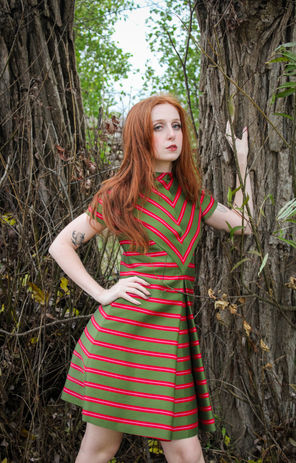Mod Brews
photographer Ella Bussa, Jack Turpen, Auset Pope
stylist Brandon Miller
journalist Jack Turpen, Ashley McDonald, Zach Hausbeck
director Sofia Serratos
graphic designer Lauren Fulk
models
Girls: Victoria Koziel, Lee Landis, Morgan Mayberry, Taylor Martin, Eva Lentine, Jaden Bridgeforth, Ella See, Jasmine Locklear, Cami Watkins, Arylon Wilks Boys: Lonnie Smith, Jordan Newbill, Trey Phillips
By 2062 we're said to have flying cars, meal pills and robots who clean and do our chores. Where are the houses in the sky? Where is life in space, jet packs and houses lined with futuristic decor and walls of windows? All according to “The Jetsons” with their mid-century modern architecture and details of retro '60s fashion. The cartoon's debut in the early 1960s not only set a highly anticipated expectation for the future of society, but it captured the presence of retrofuturism, and now in today's realm of interior design and aesthetics, the '60s are back with more funk, more flare and no shortage of patterns.
Fashion has had its ups and downs since we can remember, but there's no doubt that the true creativity and expression of style came to life at the beginning of the '60s, and there are more than enough trends, celebrity icons and designer brands to prove just how phenomenal this era came to be. Valentino made its debut in 1962 after being displayed in an Italian fashion show where the brand caught the eyes of social elites. In his rise to fame, designer Valentino Garavani crafted pieces for stars like Jackie Kennedy and Aubrey Hepburn. Many of his designs resembled elegance and prestige: evening dresses and gowns with dainty sequin detailing, silk layering, one-piece couturier and cocktail attire with the classic sexy Valentino red taking the front stage.
Kennedy not only furthered Valentino's influence, but she created an image for herself through her fashion statements, and they remain with her name to this day. Sporting a bouffant, high-rise Italian cut, Jackie Kennedy's hair paired well with classy mid-length dresses, pearls and gloves. On other days, matching patterned sets: a collared button-down jacket with a pleated skirt. A long coat with classic black heels never failed to accentuate her opulence. A bit less presidential but nevertheless iconic, Priscilla Presley paved the decade with groundbreaking taste. She stood alongside her husband, Elvis Presley, wearing mixes of high-waisted silhouettes, metallics, high necklines and long gowns for the red carpet and mini dresses, all reflecting the shifting trends of the decade. Her dramatic eye makeup and hair made her mark on the world, but she wasn’t the only one. How much mascara is too much mascara? Infamous English model Twiggy popularized the “doe eye” look with excessive black eyeliner and long distracting lashes. Priscilla did much the same, now known for her dark makeup paired with jet-black hair. All in all, the ‘60s were more daring than any fashion presence the world had seen before, and Hollywood was letting it take its course.
Contrary to the high-coverage skirts and dresses of the flapper era, the mid-60s introduced the craze of miniskirts thanks to British designer Mary Quant. A new era of young-age feminism arose from such a new silhouette. There was a sort of rebellious spirit that bloomed with the presence of such bold new aesthetics. Before this decade, female fashion was relatively tame due to societal standards and powerful male preferences. Long dresses of the Victorian era were considered the baseline of female fashion, with long sleeves and corsets tight enough to take the crowd’s breath away… and the fabulous ladies wearing them, literally. The 1920s were littered with draping, less figure-focused dresses, and plenty of headwear, but overall, still relatively modest. Yet, as decades came and went, the ‘60s were preparing to change the world of fashion completely. This decade pulled away from traditional dressing and introduced a bold and experimental look that opened fashion to be something entirely more expressive and creative. Not only were women taking a liking to new lengths, funky tights and the freedom of this newfound stylistic revolt, but men, too, were steering away from basic trousers, button-downs and suits. Bob Dylan could be found sporting a scarf, striped attire or maybe even polka dots almost as frequently as he was seen with his guitar. Although there were feministic undertones to the ‘60s fashion movement, there was also an opportunity for men to step away from the classic borders of style.
So, if loud florals, kitten heels and big hair were the fad of the time, why were the Jetsons so caught up in space and robots? Why wasn’t Jane Jetson more worried about finding the perfect pair of go-go boots? A great deal of the mid-century, the ‘60s specifically, was concerned about the future. With U.S. space exploration taking great strides, there was more attention on the potential of upcoming decades and, more importantly, the turn of the century. The cartoon “The Jetsons” illustrated how society at the time envisioned technological advancements. Sci-fi elements, architecture and fashion all merged to create a unique aesthetic now labeled as “retrofuturism.” While the term was chosen in the late 1960s to explain the odd crossover between fashion and the future, it’s now defined as one of the two: past decades’ imagination of the future or modern reinterpretations of how older eras viewed their fate. Retrofuturism was captured by ultra-modern homes with a twinge of ‘60s style, elaborate houses with unique windows, eclectic paintings and geometric furniture styles. With fashion, many designers and magazines highlighted models wearing futuristic numbers, space-like helmets, metallic dresses and boots, robot-like garments and even goggles. Space and the evolution of technology were intertwined with the retro vintage, vintage-looking fashion of this era, creating an interesting visual palette.
Retrofuturism made its way into interior design almost as significantly as it did with fashion. Today, some confidently say the aesthetic is creeping back into architecture. Houses from this era are unique in their square-based shapes. Boxy builds, flat roofs and diagonal structures, all now commonly known as “Frank Lloyd Wright” designs, an architect with a specific eye for geometric infrastructure. Social media trends have recently shown interior design trends that replicate those of the ‘60s. People are bringing back conversation pits, rich wooden floors and walls. Significant names in the media, such as Emma Chamberlain and Kendall Jenner, have also done their fair share of inspiring viewers with their stunning homes, both having a sprinkle of retro yet modern styles. Jenner revealed her home tour on YouTube four years ago, and it has reached over 30 million views. Needless to say, her home’s funky rugs, starkly colored furniture, arched doorways and plants attracted the eyes of many. The inviting warmth of this style is admirable; YouTube star and model Emma Chamberlain followed suit in 2022, showing off her newly remodeled LA mansion in an Architectural Digest video. The home is certainly inspired by retro-futuristic elements with natural wood trim, blue sofas, ultra-modern lamps, wacky wall art and the kind of natural lighting homeowners dream of. Her kitchen alone– green cupboards and skylights– could make an interior designer shed some tears. It’s a beautiful design directly derived from the artistic freedom brought by the ‘60s.
The spark of retro-modern style is going nowhere. It’s a vision that can be changed, updated, tweaked and elevated. Usually, when people refer to timeless looks, we think of simple whites, blacks, tame outfits and calm, clean homes that resemble decades before us. But can something as vivacious as ‘60s fashion also be timeless? Trends like funky tights, chunky boots and miniskirts have never truly dissipated. In fact, ‘60s fashion is abundantly right in front of our faces all the time. Patterns, women’s freedom to dress however wild they’d like, the comeback of bell bottoms and wild fringe bangs. How can we determine certain styles as timeless when even the liveliest eras of fashion are standing strong today? The Jetsons may have let us down with their far-off theories of flying cars, and we don’t have robots serving us dinner quite yet, but we do have the rich roots of mid-century fashion, and for that, the ‘60s certainly did not disappoint.







